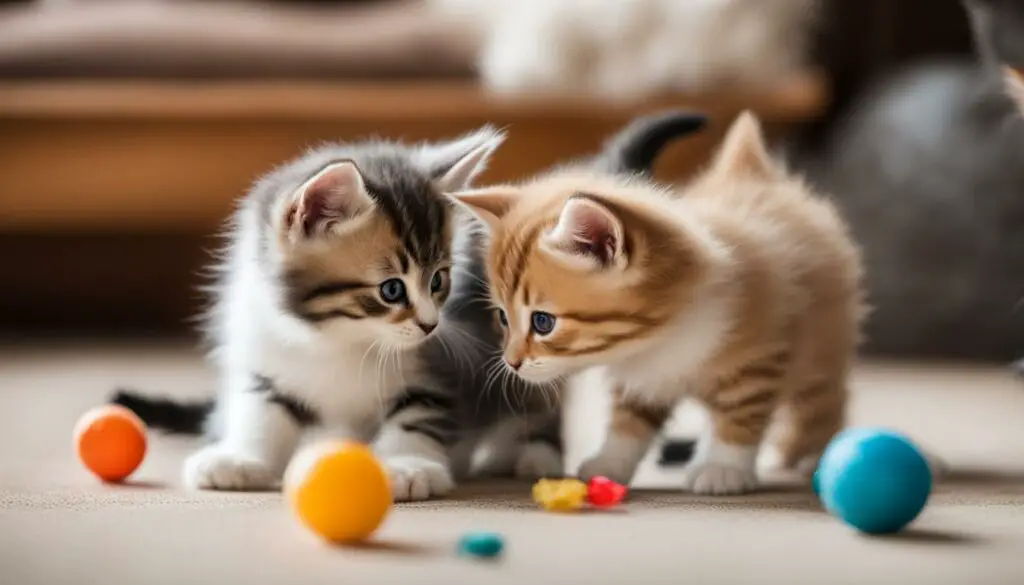Welcome to my guide on how to introduce kittens to each other. If you’re considering bringing a new kitten into your furry family, it’s important to approach the introduction process with care and patience. By following the right steps, you can create a harmonious environment where your kittens can socialize and bond with each other. In this article, I will provide you with expert tips and advice on successfully introducing kittens to each other, ensuring a smooth transition for everyone involved.
Key Takeaways:
- Introducing kittens to each other requires careful planning and gradual steps.
- Consider the nature of cats and their preferences before introducing a new kitten.
- Follow the basic steps of introducing cats or kittens.
- When introducing kittens, consider introducing a sibling pair if possible.
- Be mindful of the resources and attention provided to each kitten.
Understanding the Nature of Cats
Before considering adding another cat to your household, it’s important to understand the nature and preferences of cats. Cats are generally solitary animals and may prefer to live alone. While some cats may enjoy the company of other feline companions, others may find it stressful or overwhelming. It’s crucial to consider whether getting another cat is the best decision for your existing cat, taking into account factors such as their preference for solitude and the level of social interaction they desire.
Each cat has its own unique personality and preferences, so it’s essential to consider how a new cat may impact your current cat’s lifestyle. Some cats thrive on playtime and social interactions, while others prefer a quiet and independent life. A decision to add another cat should take into consideration the needs and preferences of both cats involved.
When introducing a new cat, it’s crucial to provide a gradual and controlled introduction process. This will give both cats an opportunity to adjust to each other’s presence and establish their own boundaries. It’s important to monitor their reactions and body language throughout the introduction to ensure their well-being and comfort. By understanding the nature of cats and respecting their preferences, you can create a harmonious environment for all feline residents in your home.
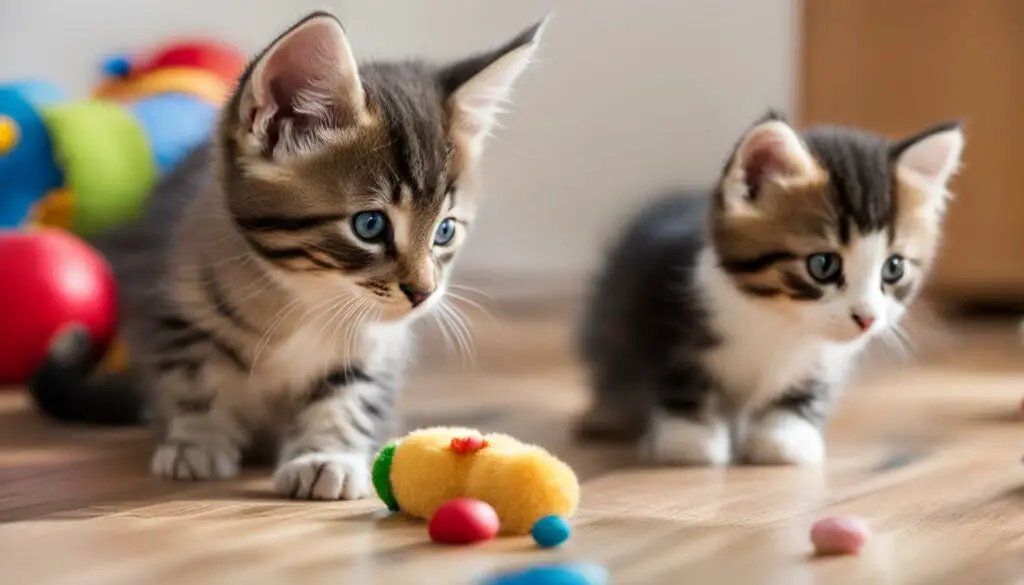
The Basic Steps of Introducing Cats or Kittens
Introducing cats or kittens requires a strategic and gradual approach to ensure a smooth and successful integration. By following these basic steps, you can create the best start for your furry friends and increase the chances of a harmonious coexistence.
- Create a Sanctuary Room: Set up a separate room, known as a sanctuary room, for the new cat or kitten. This space provides them with their own territory where they can feel safe and gradually adjust to their new surroundings.
- Scent Swapping: Scent is an important aspect of cat communication. To help your cats or kittens get used to each other’s smell, engage in scent swapping. Use a cloth or glove to rub one cat’s scent onto the other and vice versa. This helps familiarize them with the scent of their new companion.
- Visual Interaction: Once the cats or kittens have become accustomed to each other’s scent, it’s time to allow them to see each other without direct contact. Use a physical barrier, such as a baby gate or screen, to ensure their safety while allowing for visual interaction. This helps them become familiar with each other’s appearance and body language.
- Face-to-Face Meeting: Finally, when both cats or kittens have shown positive responses to scent swapping and visual interaction, it’s time for a controlled face-to-face meeting. Keep the initial meetings short and supervised, ensuring a positive and calm environment. Provide treats and praise for good behavior to create positive associations.
By following these basic steps, you are creating an environment that encourages gradual familiarity and positive interactions between your cats or kittens. Remember, every cat is unique, and the introduction process may take time. Patience, consistency, and attentiveness to their needs are vital for a successful integration.
| Step | Description |
|---|---|
| Create a Sanctuary Room | Set up a separate room where the new cat or kitten can have their own space and time to adapt to the new environment. |
| Scent Swapping | Exchange scents between the cats or kittens using a cloth or glove to help them become familiar with each other’s scent. |
| Visual Interaction | Allow the cats or kittens to see each other through a physical barrier, such as a baby gate, ensuring their safety while promoting visual interaction. |
| Face-to-Face Meeting | Once the cats or kittens have shown positive responses to scent swapping and visual interaction, introduce them for controlled face-to-face meetings, rewarding good behavior and providing a calm environment. |
“Introducing cats or kittens requires a careful and gradual process to ensure a successful integration. Providing a sanctuary room, swapping scents, allowing visual interaction, and gradually introducing face-to-face meetings are the key steps to create a harmonious furry family.”
Remember, every cat is unique, and the introduction process may vary. It’s essential to be patient, observant, and responsive to each cat’s behavior and comfort levels. Following these steps and monitoring their progress will help you establish a positive and peaceful relationship between your cats or kittens.
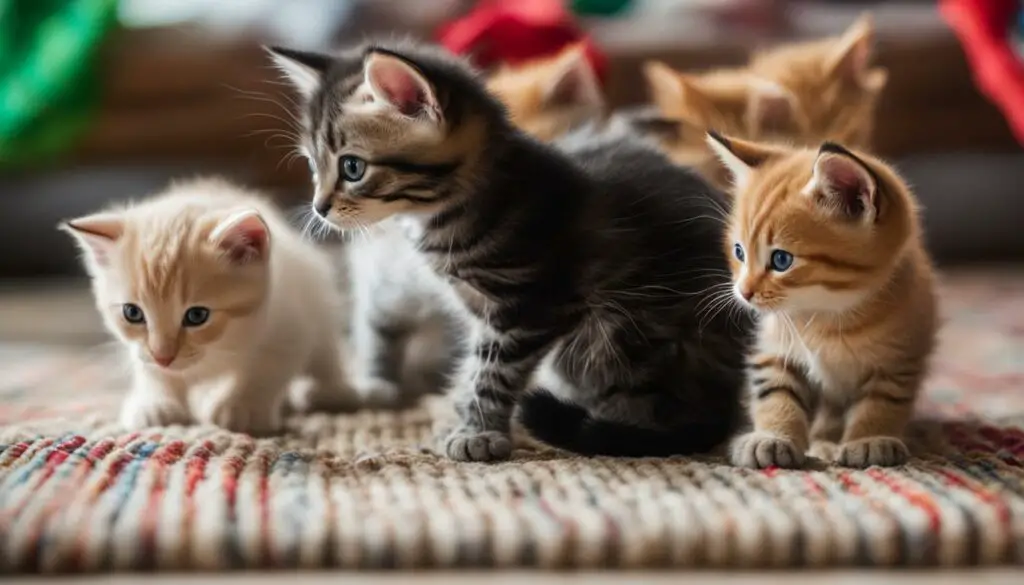
Introducing Kittens
Introducing kittens to each other can be an exciting and rewarding experience. Whether you’re bringing home a sibling pair or introducing a new kitten to your resident cat, there are a few considerations to keep in mind. One of the best ways to increase the chances of a successful introduction is to start with a sibling pair. Siblings often have an existing bond and are more likely to get along well.
Age also plays a role in the success of introducing kittens. Kittens of similar ages tend to have more compatible energy levels and play styles, making it easier for them to form bonds. Providing enough attention and resources is essential when introducing kittens. Each kitten should have access to their own food, water, litter box, and toys to reduce competition and prevent conflicts.
Creating a nurturing environment and ensuring each kitten feels loved and cared for will go a long way in fostering positive relationships between them. Taking the time to properly introduce kittens and providing them with the attention and resources they need will set them up for a happy and harmonious life together.
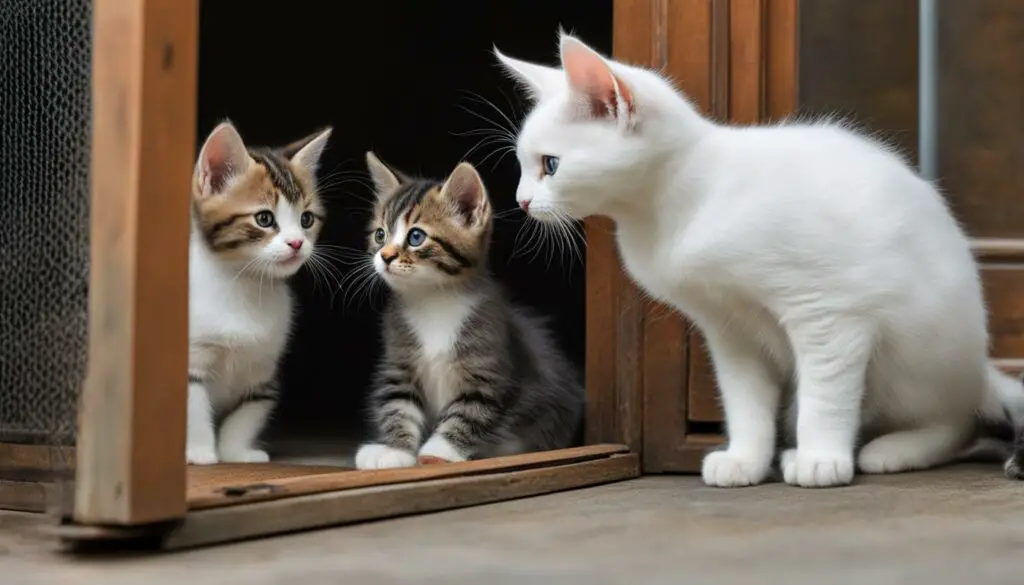
Table: Age Considerations for Introducing Kittens
| Kitten Age | Considerations |
|---|---|
| Under 8 weeks | Kittens are still developing social skills and may need extra guidance and supervision during introductions. |
| 8-12 weeks | Kittens are more independent and can handle short, supervised interactions with other kittens. |
| 12-16 weeks | Kittens have developed stronger social skills and can engage in longer play sessions with other kittens. |
“Introducing kittens to each other is an exciting process that requires careful planning and consideration. By starting with a sibling pair and considering age and resources, you can increase the chances of a successful introduction and create a loving and harmonious environment for your furry friends.”
Introducing a Kitten to an Adult Cat
Introducing a kitten to an adult cat requires careful consideration and some additional steps. There are a few barriers you can use to separate them initially, such as pet gates or screen doors. This ensures that the kitten cannot slip through any gaps and allows for controlled visual contact.
It’s important to tire the kitten out through play before introducing them to the adult cat. This can help prevent constant annoyance to the older cat and reduce the potential for conflict. Consistency is key during this process, as it helps the cats establish a routine and understand what is expected of them.
During the introduction, it’s crucial to give the adult cat space to retreat if needed. Providing separate areas for each cat to eat, sleep, and use the litter box can help prevent resource guarding and reduce competition. Feeding the cat and kitten apart may also be beneficial, as their dietary needs may differ.
When introducing a kitten to an adult cat, it’s important to take things slowly and monitor their interactions closely. Keep in mind that each cat is unique and may require different amounts of time to adjust to each other. By following these guidelines and being mindful of the cats’ needs, you can increase the chances of a successful introduction and foster a harmonious relationship between the two.
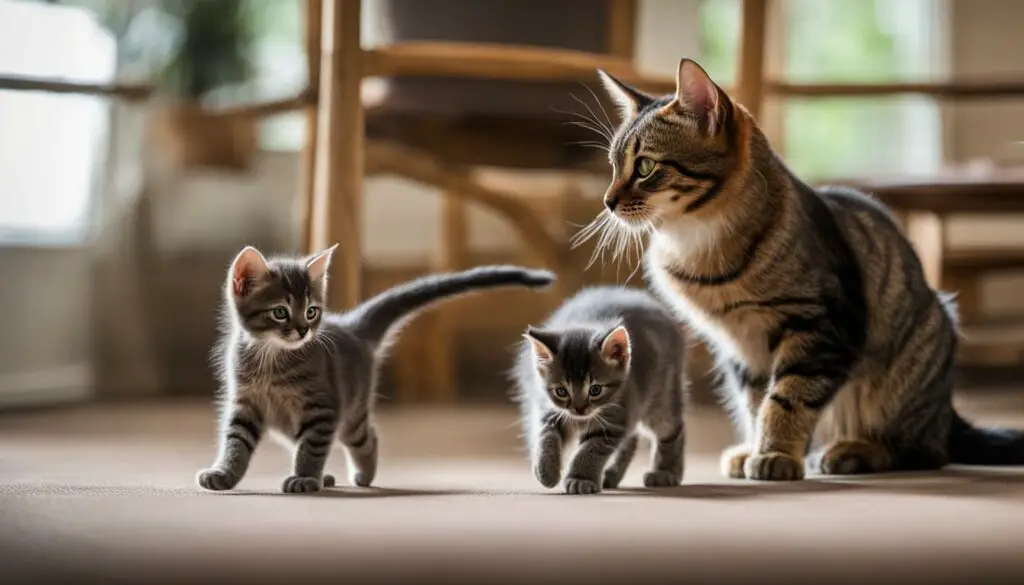
Key Considerations for Introducing a Kitten to an Adult Cat:
- Use barriers such as pet gates or screen doors to separate the cats initially.
- Tire the kitten out through play before introducing them.
- Maintain consistency in providing attention and establishing a routine.
- Give the adult cat space to retreat if needed.
- Be mindful of resources and separate feeding areas if necessary.
- Monitor the interactions closely and take things at a pace that works for both cats.
Introducing Adult Cats
Introducing adult cats can be a bit more complex than introducing kittens due to their established personalities. The key to a successful introduction is considering the cats’ individual personalities and providing them with the necessary resources. Each cat needs their own food bowls, water bowls, litter trays, and beds to minimize competition and create a sense of security.
When introducing adult cats, it’s important to take your time and go at their pace. Rushing the process can lead to stress and potential conflicts. Allow the cats to gradually become familiar with each other’s scents by using scent swapping techniques, such as exchanging bedding and using gloves or a cloth to transfer scents onto furniture.
Using artificial pheromones, such as Feliway, can also help reduce stress and increase the chances of a successful introduction. These pheromones create a calming environment for the cats and can help them feel more comfortable in each other’s presence. It’s important to monitor their interactions closely and be prepared to intervene if any conflicts arise.
| Considerations | Actions |
|---|---|
| Understanding personalities | Take into account each cat’s temperament, behavior, and preferences to anticipate potential challenges. |
| Providing resources | Ensure each cat has their own food bowls, water bowls, litter trays, and beds to minimize competition. |
| Taking time | Allow the cats to adjust to each other’s presence gradually, avoiding rushed introductions. |
| Using pheromones | Consider using artificial pheromones, such as Feliway, to create a calming environment for the cats. |
With patience, careful consideration of their personalities, and the use of appropriate resources and pheromones, introducing adult cats can be a successful and rewarding experience. Remember to prioritize their well-being throughout the process and provide a safe and comfortable environment for both cats.
Signs of Cat Bullying and How to Address It
In multi-cat households, it’s important to be aware of the signs of cat bullying and take appropriate measures to address it. Bullying behaviors can disrupt the harmony and well-being of your feline companions. By recognizing these signs and implementing strategies to combat bullying, you can create a peaceful and safe environment for all your cats.
Signs of Cat Bullying
Cat bullying can manifest in various ways. Some common signs include:
- Staring: One cat repeatedly staring at another in an intimidating or aggressive manner.
- Claiming resting places: Bullying cats may forcefully claim specific resting spots, such as beds or cozy corners.
- Pouncing: One cat unexpectedly launching an attack on another, often without provocation.
- Blocking access: A bullying cat may prevent another cat from entering certain areas of the house, such as doorways or litter box locations.
- Emotionally blocking resources: Cats engaging in bullying behavior might guard essential resources like food, water, or toys, causing distress to other cats.
Identifying these signs is essential in addressing cat bullying and promoting a harmonious coexistence among your furry companions.
Combating Cat Bullying
Addressing cat bullying requires implementing effective strategies. Here are some steps you can take:
- Provide sufficient resources: Ensure each cat has access to their own food bowls, water bowls, litter trays, and resting areas. This reduces the likelihood of competition and minimizes potential conflicts.
- Separate feeding areas: To prevent resource guarding, feed your cats in separate locations. This allows each cat to eat without feeling threatened or pressured.
- Multiple entry and exit points: Create multiple access points throughout your home to allow cats to move freely without feeling trapped or ambushed by a bullying cat.
- Implement visual barriers: Use objects such as cardboard screens or furniture to create physical barriers between cats, giving them space and reducing the opportunity for confrontations.
By implementing these strategies and closely monitoring your cats’ behavior, you can effectively combat cat bullying and foster a peaceful living environment for all your beloved feline friends.
| Signs of Cat Bullying | How to Address It |
|---|---|
| Staring | Intervene by redirecting attention or creating physical barriers. |
| Claiming resting places | Provide multiple comfortable resting areas for each cat and encourage sharing. |
| Pouncing | Engage in interactive play sessions with both cats to channel excess energy and reduce aggression. |
| Blocking access | Create alternative entryways or pathways to prevent cats from blocking each other’s access. |
| Emotionally blocking resources | Ensure each cat has access to essential resources and consider using puzzle feeders to occupy their attention. |
Understanding the Duration of the Introduction Process
When it comes to introducing a new cat or kitten to your resident cat, there is no set timeline for how long the process may take. Every cat is unique and will adapt at their own pace. It’s important to be patient and allow both cats to set their own comfort levels.
Adapting to a new cat or kitten can be a gradual process, and it’s important to recognize and respect your resident cat’s boundaries. Keep a close eye on their body language and behavior to gauge their comfort levels. Signs of stress or discomfort may include hissing, growling, or hiding. If you notice these signs, it’s essential to slow down the introduction process and give both cats more time to acclimate.
Reading your cat’s body language is key to understanding their emotions and level of comfort. Tail movements, ear positions, and the overall stance of your cat can provide valuable clues about how they are feeling. It’s important to be observant and responsive to their needs throughout the introduction process to ensure a positive outcome.
| Recognizing Comfort Levels | Body Language |
|---|---|
| Relaxed and confident | Relaxed posture, slow blinking, tail held upright |
| Moderately comfortable | Slightly tense body, dilated pupils, tail held low but not tucked |
| Uncomfortable or stressed | Tail tucked, ears flattened, growling or hissing |
“Understanding your cat’s comfort levels is crucial during the introduction process. By reading their body language and recognizing the signs of stress, you can adjust the pace and create a more positive experience for both cats.”
– Cat Behavior Expert
Remember, the goal of the introduction process is to create a harmonious coexistence between your cats. Rushing the process or forcing interactions can lead to a strained relationship. It’s important to prioritize the well-being and comfort of both cats, even if it means taking more time than anticipated. With patience, understanding, and respect for your cats’ individual needs, you can increase the chances of a successful and peaceful introduction.
Setting Up the Home for a New Cat
Introducing a new cat to your home requires careful preparation to ensure a smooth transition. By setting up the environment appropriately, you can create a comfortable and secure space for your new furry friend. Begin by confining the new cat to a single room, commonly referred to as a “sanctuary room.” This room should be equipped with all the essential items your cat will need.
In the sanctuary room, provide the new cat with food and water bowls, a comfortable bed or resting area, hiding places such as cat trees or boxes, a litter tray filled with their preferred litter, and a variety of toys to keep them entertained. It’s important to choose toys that are safe and appropriate for their age and size. Additionally, make sure to include scratching posts or pads to fulfill their natural instinct to scratch.
To help your new cat feel familiar and secure in their surroundings, consider using synthetic feline facial pheromone spray, such as Feliway Classic. This pheromone mimics the natural scent cats leave when they rub their faces on objects, creating a sense of familiarity and comfort. Spray Feliway Classic on furniture, bedding, and other surfaces in the sanctuary room to help alleviate stress and anxiety for your new cat.

Allow your new cat some time to explore and acclimate to the sanctuary room before proceeding with introductions to other areas of the home. This will give them an opportunity to become familiar with their scent and establish a sense of safety and security. Once your new cat has settled in and adapted to their surroundings, you can gradually introduce them to the rest of the house, one room at a time.
| Essential Items for the Sanctuary Room: |
|---|
| Food and water bowls |
| Comfortable bed or resting area |
| Hiding places (cat trees, boxes, etc.) |
| Litter tray with preferred litter |
| Toys appropriate for their age and size |
| Scratching posts or pads |
Remember, every cat is unique, and the time it takes for them to adjust to their new home may vary. Patience and a gradual approach are key to ensuring a successful and stress-free transition for your new cat.
Scent Swapping
Scent swapping is a crucial step in the introduction process when bringing new cats or kittens into your home. It helps familiarize them with each other’s scent, making the integration smoother. There are several methods you can use to facilitate scent swapping and create a communal scent for your feline friends.
- Exchanging bedding: Start by exchanging the bedding of each cat. This allows their scents to mix and creates a sense of familiarity. Place the bedding near their resting areas, so they can become accustomed to each other’s scent.
- Use of gloves or cloth: Another way to promote scent exchange is by using gloves or a cloth. Gently rub the gloves or cloth on one cat, then transfer the scent to the furniture or other items in the house. Repeat the process with the other cat, allowing their scents to mix further.
- Allow exploration of each cat’s area: Once the cats are comfortable with the scent swapping, you can allow them to briefly explore each other’s areas. This can be done by supervising their movements or using a pet gate to separate them physically while still allowing visual and olfactory contact. This step helps them become familiar with each other’s territory.
Remember, scent swapping is an essential part of the introduction process, as it helps cats recognize each other’s presence and reduces the likelihood of aggressive behavior. By incorporating these scent swapping techniques, you can increase the chances of a successful introduction and the formation of a harmonious cat household.
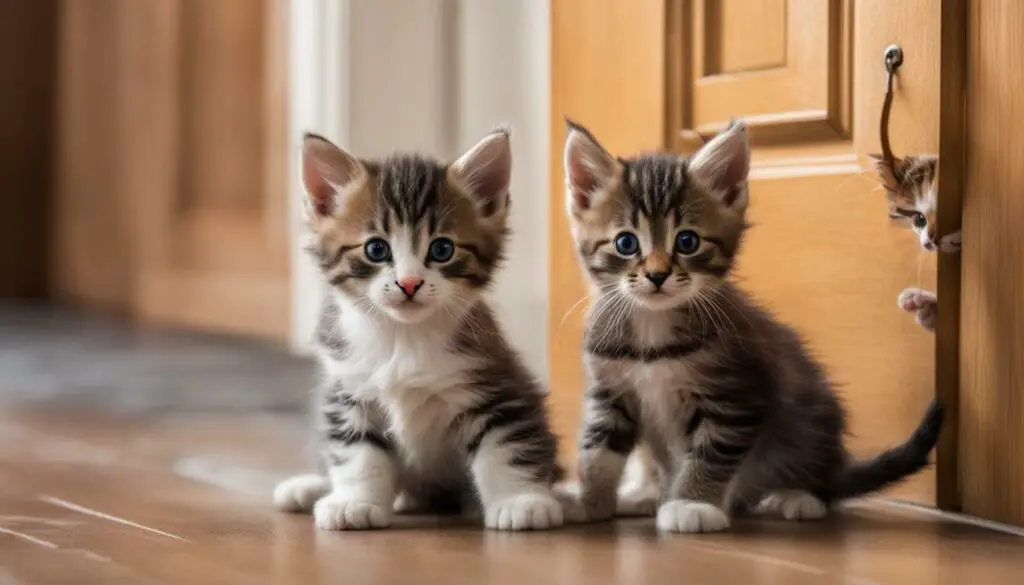
Allowing Visual Contact
Once the cats have become comfortable with each other’s scents, it’s time to move on to allowing visual contact. This step is crucial in helping them get used to each other’s presence and establishing a positive association. Visual contact should be introduced gradually and through the use of physical barriers to ensure a safe and controlled environment.
There are various options for physical barriers that can be used to enable visual contact. Partially opened doors, mesh barriers, or pet gates can be effective in allowing the cats to see each other without direct access. It’s important to choose a buffer barrier that provides enough visibility while still maintaining a sense of safety and control.
A technique called “raising the curtain” can be employed to gradually increase visual access between the cats. This involves draping a blanket or using clothespins to control the degree of visibility. By slowly raising the curtain over time, the cats can become more accustomed to seeing each other without feeling overwhelmed.
Choosing a Buffer Barrier
When selecting a physical barrier for visual contact, it’s essential to consider the individual circumstances and needs of the cats involved. Some cats may be more confident and comfortable with a wide-open view, while others may require a more gradual approach with limited visibility. Assessing the cats’ behavior and reactions during previous stages of the introduction process can help determine the most suitable buffer barrier.

| Pros of Partially Opened Doors | Cons of Partially Opened Doors |
|---|---|
| Allows cats to see each other clearly | May result in heightened stress or aggression if cats are not ready for direct visual contact |
| Provides an opportunity for positive experiences, such as playing with toys or engaging in food-related activities, through the gap | Can be challenging to control the cats’ reactions and interactions |
- Potential visual contact barriers:
- Mesh barriers
- Pet gates
- Raising the curtain technique:
- Gradually increase visual access by draping a blanket or using clothespins to control the degree of visibility
- Positive experiences such as feeding or playtime can be associated with visual contact
Visual contact should always be accompanied by positive experiences to reinforce the idea that being in each other’s presence is a pleasant and rewarding experience. Feeding the cats in close proximity or engaging them in interactive play sessions while within sight of each other can help create positive associations and reduce any potential tension.
Remember, the introduction process is unique to each set of cats, and it’s crucial to go at their pace. Monitor their behavior and reactions closely during visual contact, ensuring their well-being and comfort throughout. With patience and persistence, you can help foster a positive relationship between your cats, creating a harmonious feline family.
Eat, Play, Love – Facilitating Positive Associations
Introducing cats to each other can be a delicate process, but with the Eat, Play, Love method, you can foster positive associations between your feline companions. By prioritizing their well-being and using these steps, you can increase the chances of a harmonious coexistence.
Establishing a Rhythm
One of the key aspects of the Eat, Play, Love method is establishing a rhythm of activities that the cats can enjoy together. This rhythm can include shared meal times, interactive play sessions, and moments of affection. Creating a consistent schedule and routine will help the cats associate each other’s presence with enjoyable experiences, building positive associations over time.
Monitoring Signs of Conflict
While facilitating positive associations is the goal, it’s important to remain vigilant and monitor any signs of conflict between the cats. Pay attention to their body language, vocalizations, and behavior during interactions. If you notice tension or aggression, it may be necessary to intervene and separate the cats temporarily to prevent escalated conflicts. Always prioritize their safety and well-being.
Preparedness for Potential Conflicts
Despite your best efforts, conflicts may still arise between the cats. Be prepared for these situations by having sight blockers, such as blankets or cardboard barriers, readily available. These can be used to create visual barriers and give each cat a sense of privacy and security. Additionally, have a plan in place for separating the cats and providing individual spaces if necessary. By being prepared for potential conflicts, you can minimize their impact and maintain a peaceful environment for your cats.

| Benefits of the Eat, Play, Love Method | Considerations |
|---|---|
|
|
Conclusion
Learning how to introduce kittens to each other is a journey that requires patience and careful steps. By following expert tips and understanding the nature of cats, you can create a harmonious furry family. Implementing the basic steps of introduction, considering the specific considerations for introducing kittens and adult cats, and addressing bullying behaviors are key to successful cat introductions.
Throughout the process, it is crucial to read your cat’s body language, go at their pace, and prioritize their well-being. Remember, there is no set timeline for the introduction process, as each cat is unique. Rushing the process can strain the relationship, so it’s essential to be attentive and recognize your cat’s comfort levels.
By creating positive associations through the Eat, Play, Love method and providing a supportive environment, you can increase the chances of a successful introduction and the formation of a harmonious furry family. With time, patience, and understanding, you can help your cats build lasting bonds and live their best lives together.
FAQ
Are cats solitary animals?
Yes, cats are generally solitary animals and may prefer to live alone.
Should I consider adding another cat to my household?
It’s important to understand your existing cat’s nature and preferences before adding another cat. Consider factors such as their preference for solitude and desired level of social interaction.
What are the basic steps of introducing cats or kittens?
The basic steps include setting up a sanctuary room, scent swapping, visual interaction, and face-to-face meetings. These steps help create a gradual and successful introduction.
Is introducing kittens easier than introducing adult cats?
Introducing kittens can be easier than introducing adult cats, especially if they are a sibling pair and of similar ages. Providing attention and resources can increase the chances of a successful introduction.
How do I introduce a kitten to an adult cat?
Use barriers to separate them initially, tire the kitten out through play, maintain consistency in attention, give them space to retreat, and be mindful of resource allocation.
How do I introduce adult cats?
Consider their personalities, provide ample resources, take time for the introduction process, and use artificial pheromones to reduce stress.
What are the signs of cat bullying and how can I address it?
Signs of cat bullying include staring, claiming resting places, pouncing, and blocking access to resources. Address it by providing sufficient resources, separating feeding areas, and implementing visual barriers.
How long does the introduction process take?
There is no set timeline, as it varies for each cat. It’s important to read your cat’s body language and go at their pace to ensure their comfort.
How do I set up the home for a new cat?
Confine the new cat to a single room initially, provide essential items, and use synthetic feline facial pheromone Feliway Classic to create a sense of familiarity and security.
What is scent swapping?
Scent swapping involves exchanging bedding and using gloves or cloth to transfer scents, allowing cats to become familiar with each other’s scent.
How do I allow visual contact between cats?
Use physical barriers such as partially opened doors or mesh barriers to gradually introduce visual contact. The “raising the curtain” technique can control the degree of visibility.
What is the Eat, Play, Love method?
The Eat, Play, Love method involves bringing both cats together for activities such as eating, playing, and providing affection to create positive associations and coexistence.

